PF := RealP / S -- by definition of power factor PF
S := Vrms * Irms -- by definition of apparent power S
If you have those two waveforms (the instantaneous voltage and instantaneous current waveform), you can
- find Irms, the RMS flow of electrons through the load over a full cycle.
Electric power supply companies prefer to make
Irms as small as possible, so their power lines don't melt from the I2R heating caused by this current.
(They can successfully reduce this number while keeping the real power the same by using very high voltages, mandating power factors closer to 1, etc.)
- find Vrms, the RMS voltage across the load over a full cycle. (In your case, this is pretty close to 120 VAC).
- find the apparent power
S := Vrms * Irms
- find a third waveform: the instantaneous real power waveform. At any one instant, the product -- of the instantaneous voltage and the instantaneous current -- gives the power going into the load at that instant. With some loads -- such as inductive motor loads -- the power waveform alternates between positive (power going into the load) and negative (power coming out of the load).
- find the average real power RealP over a full cycle (the plain average, not the RMS).
- find the power factor PF := RealP / S
As far as I know, that's the only way to calculate the power factor for non-sinusoidal loads.
(All other formulas I've seen for power factor end up doing the same or more calculations, perhaps in some other order with other names for the intermediate terms, or else are wrong).
unnecessary rant
Some textbooks imply that calculating the power factor involves first taking the cosine of something, perhaps something related to zero-crossings. That's doing it wrong. It may happen to give the currect result for perfectly linear loads with ideal sine-wave power, but not for nonlinear loads, or linear loads with our less-than-ideal not-exactly-sine-wave power. Instead, good power monitoring devices use the above equation, which gives the correct power factor even with nonlinear loads or non-sine-wave power or both.
Some textbooks imply that one can calculate the real power by multiplying the power factor times something. That is an unnecessarily round-about method of getting the real power, since the device must have already calculated the real power in order to get the power factor.
None of the formulas for calculating power factor in terms of phase shift will work for you.
Those "phase angle" formulas only apply when both the voltage and the current are sinusoidal.
(I ranted about this before, in places like
Power monitoring 240VAC devices
).
